A Comprehensive Report on Organisational Behaviour at 1spatial Plc
VerifiedAdded on 2020/12/18
|19
|5278
|327
Report
AI Summary
This report delves into the intricacies of organisational behaviour, focusing on its application within 1spatial Plc. It examines the influence of workplace politics, power structures, and organisational culture, including the Handy Culture Model, on individual and group behaviour. The report further explores motivation theories, such as Maslow's hierarchy of needs and Vroom's expectancy theory, and their impact on effective management. It investigates the formation and dynamics of effective teams, contrasting them with ineffective ones. The analysis provides insights into how different organisational cultures affect employee behaviour and performance, offering practical implications for improving organisational effectiveness. The report concludes with a discussion on the importance of motivation and its various techniques in fostering a productive work environment.
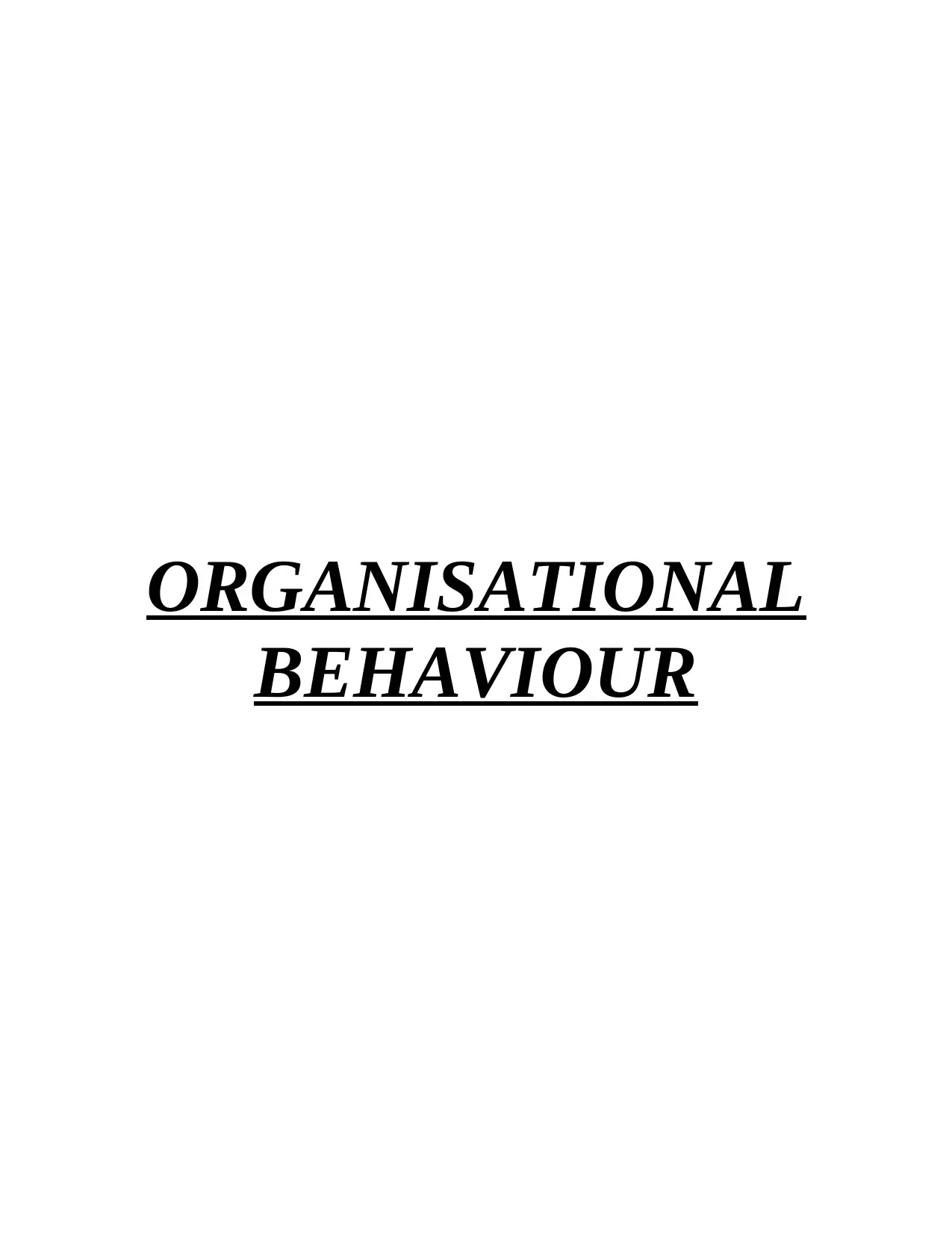
ORGANISATIONAL
BEHAVIOUR
BEHAVIOUR
Paraphrase This Document
Need a fresh take? Get an instant paraphrase of this document with our AI Paraphraser
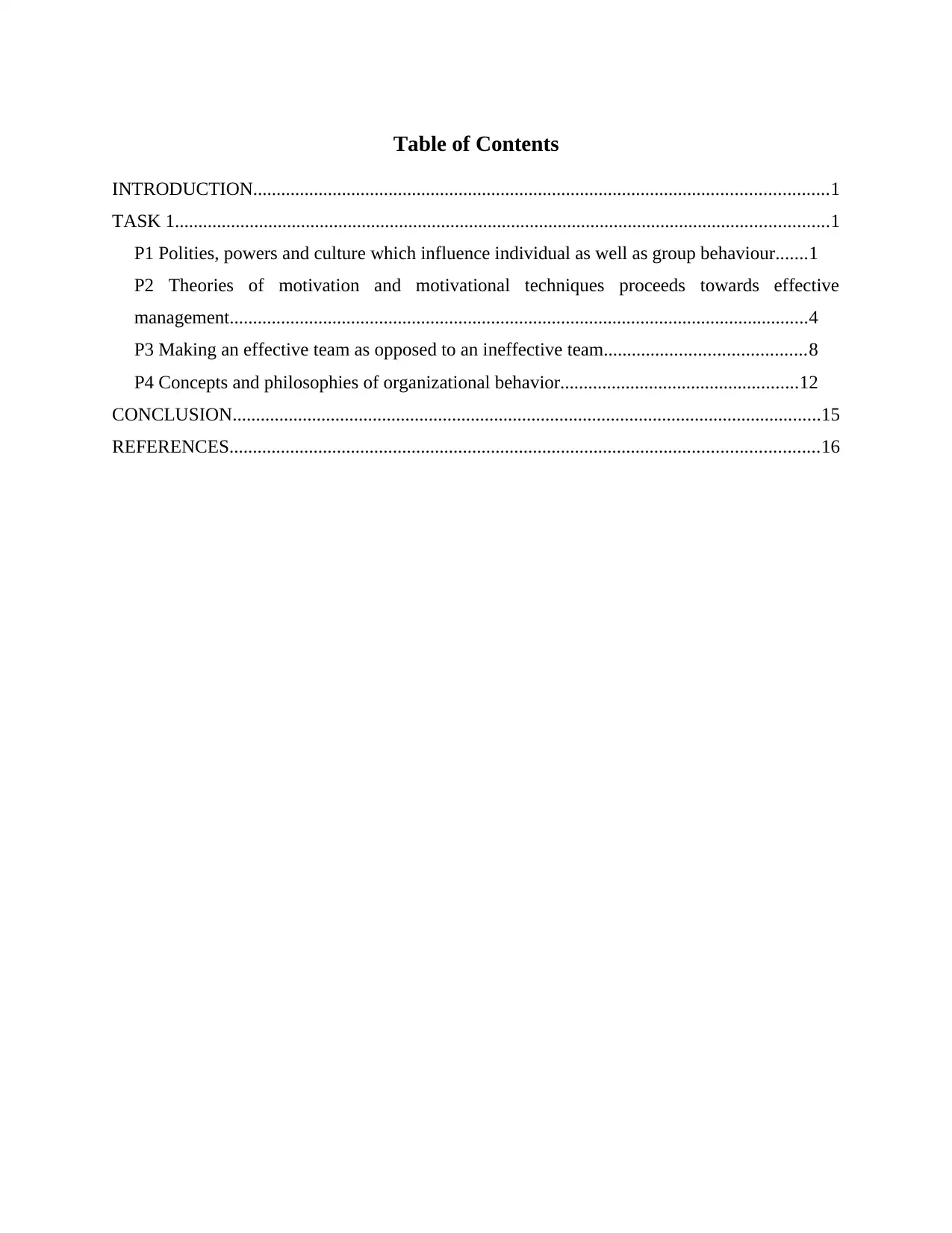
Table of Contents
INTRODUCTION...........................................................................................................................1
TASK 1............................................................................................................................................1
P1 Polities, powers and culture which influence individual as well as group behaviour.......1
P2 Theories of motivation and motivational techniques proceeds towards effective
management............................................................................................................................4
P3 Making an effective team as opposed to an ineffective team...........................................8
P4 Concepts and philosophies of organizational behavior...................................................12
CONCLUSION..............................................................................................................................15
REFERENCES..............................................................................................................................16
INTRODUCTION...........................................................................................................................1
TASK 1............................................................................................................................................1
P1 Polities, powers and culture which influence individual as well as group behaviour.......1
P2 Theories of motivation and motivational techniques proceeds towards effective
management............................................................................................................................4
P3 Making an effective team as opposed to an ineffective team...........................................8
P4 Concepts and philosophies of organizational behavior...................................................12
CONCLUSION..............................................................................................................................15
REFERENCES..............................................................................................................................16

⊘ This is a preview!⊘
Do you want full access?
Subscribe today to unlock all pages.

Trusted by 1+ million students worldwide
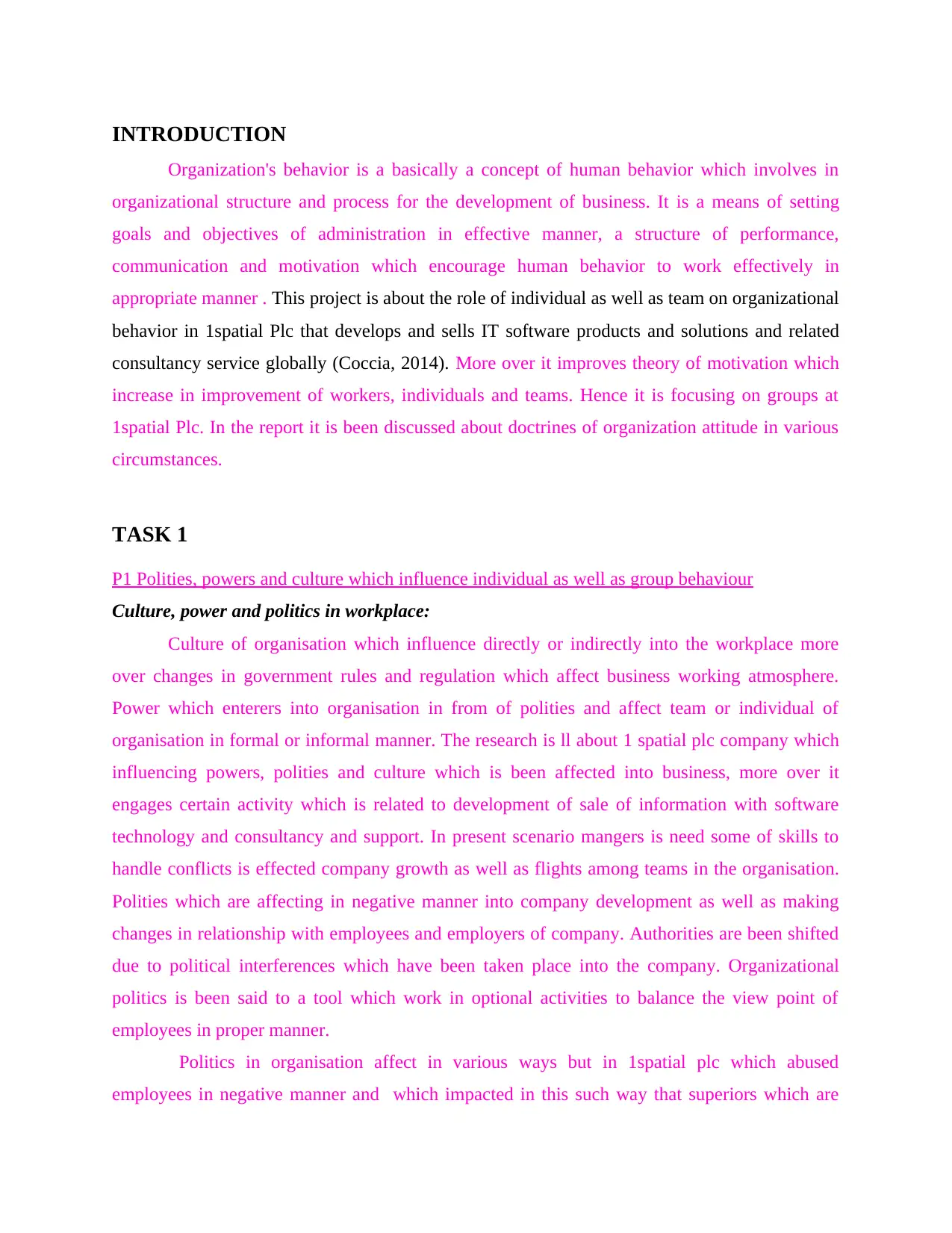
INTRODUCTION
Organization's behavior is a basically a concept of human behavior which involves in
organizational structure and process for the development of business. It is a means of setting
goals and objectives of administration in effective manner, a structure of performance,
communication and motivation which encourage human behavior to work effectively in
appropriate manner . This project is about the role of individual as well as team on organizational
behavior in 1spatial Plc that develops and sells IT software products and solutions and related
consultancy service globally (Coccia, 2014). More over it improves theory of motivation which
increase in improvement of workers, individuals and teams. Hence it is focusing on groups at
1spatial Plc. In the report it is been discussed about doctrines of organization attitude in various
circumstances.
TASK 1
P1 Polities, powers and culture which influence individual as well as group behaviour
Culture, power and politics in workplace:
Culture of organisation which influence directly or indirectly into the workplace more
over changes in government rules and regulation which affect business working atmosphere.
Power which enterers into organisation in from of polities and affect team or individual of
organisation in formal or informal manner. The research is ll about 1 spatial plc company which
influencing powers, polities and culture which is been affected into business, more over it
engages certain activity which is related to development of sale of information with software
technology and consultancy and support. In present scenario mangers is need some of skills to
handle conflicts is effected company growth as well as flights among teams in the organisation.
Polities which are affecting in negative manner into company development as well as making
changes in relationship with employees and employers of company. Authorities are been shifted
due to political interferences which have been taken place into the company. Organizational
politics is been said to a tool which work in optional activities to balance the view point of
employees in proper manner.
Politics in organisation affect in various ways but in 1spatial plc which abused
employees in negative manner and which impacted in this such way that superiors which are
Organization's behavior is a basically a concept of human behavior which involves in
organizational structure and process for the development of business. It is a means of setting
goals and objectives of administration in effective manner, a structure of performance,
communication and motivation which encourage human behavior to work effectively in
appropriate manner . This project is about the role of individual as well as team on organizational
behavior in 1spatial Plc that develops and sells IT software products and solutions and related
consultancy service globally (Coccia, 2014). More over it improves theory of motivation which
increase in improvement of workers, individuals and teams. Hence it is focusing on groups at
1spatial Plc. In the report it is been discussed about doctrines of organization attitude in various
circumstances.
TASK 1
P1 Polities, powers and culture which influence individual as well as group behaviour
Culture, power and politics in workplace:
Culture of organisation which influence directly or indirectly into the workplace more
over changes in government rules and regulation which affect business working atmosphere.
Power which enterers into organisation in from of polities and affect team or individual of
organisation in formal or informal manner. The research is ll about 1 spatial plc company which
influencing powers, polities and culture which is been affected into business, more over it
engages certain activity which is related to development of sale of information with software
technology and consultancy and support. In present scenario mangers is need some of skills to
handle conflicts is effected company growth as well as flights among teams in the organisation.
Polities which are affecting in negative manner into company development as well as making
changes in relationship with employees and employers of company. Authorities are been shifted
due to political interferences which have been taken place into the company. Organizational
politics is been said to a tool which work in optional activities to balance the view point of
employees in proper manner.
Politics in organisation affect in various ways but in 1spatial plc which abused
employees in negative manner and which impacted in this such way that superiors which are
Paraphrase This Document
Need a fresh take? Get an instant paraphrase of this document with our AI Paraphraser
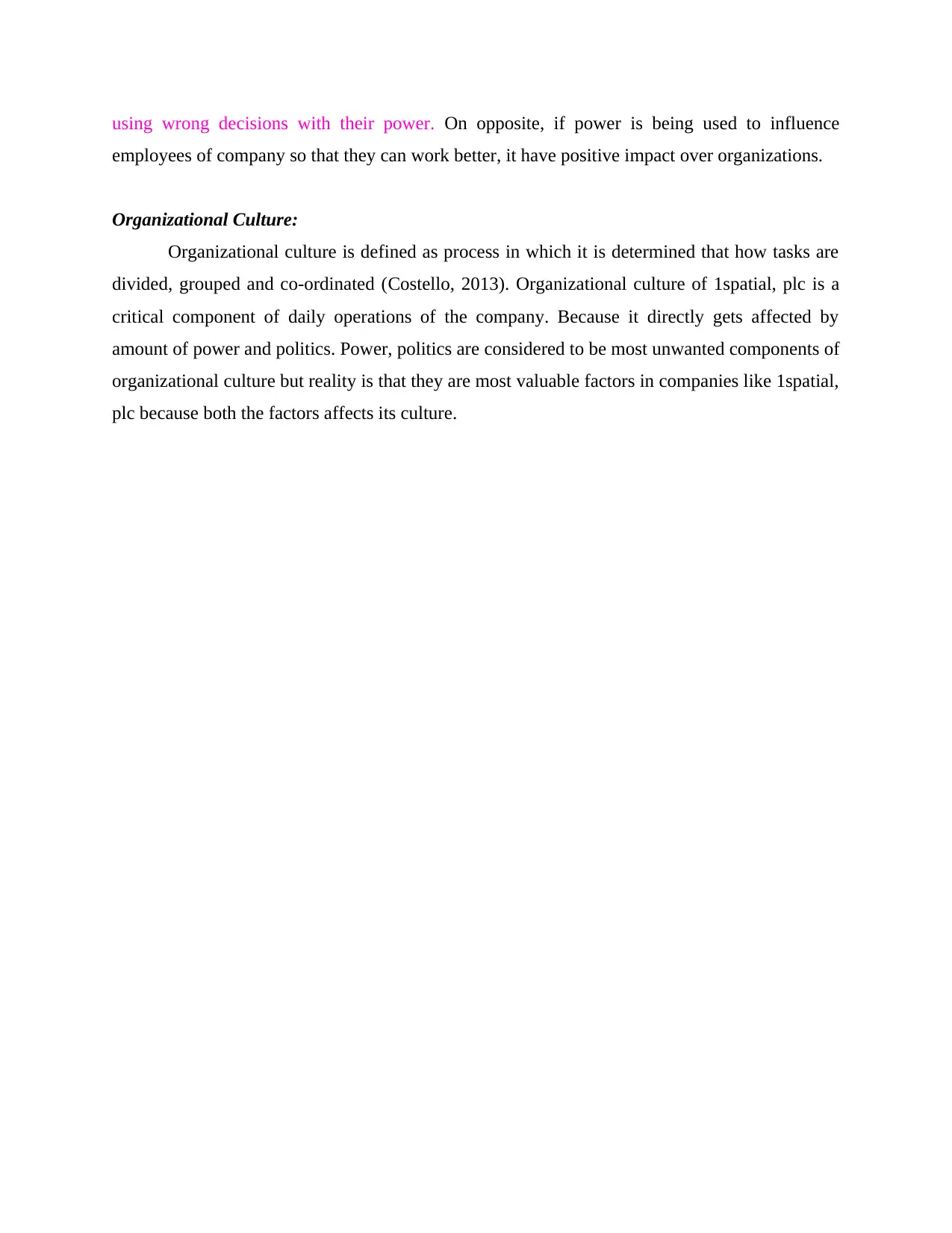
using wrong decisions with their power. On opposite, if power is being used to influence
employees of company so that they can work better, it have positive impact over organizations.
Organizational Culture:
Organizational culture is defined as process in which it is determined that how tasks are
divided, grouped and co-ordinated (Costello, 2013). Organizational culture of 1spatial, plc is a
critical component of daily operations of the company. Because it directly gets affected by
amount of power and politics. Power, politics are considered to be most unwanted components of
organizational culture but reality is that they are most valuable factors in companies like 1spatial,
plc because both the factors affects its culture.
employees of company so that they can work better, it have positive impact over organizations.
Organizational Culture:
Organizational culture is defined as process in which it is determined that how tasks are
divided, grouped and co-ordinated (Costello, 2013). Organizational culture of 1spatial, plc is a
critical component of daily operations of the company. Because it directly gets affected by
amount of power and politics. Power, politics are considered to be most unwanted components of
organizational culture but reality is that they are most valuable factors in companies like 1spatial,
plc because both the factors affects its culture.
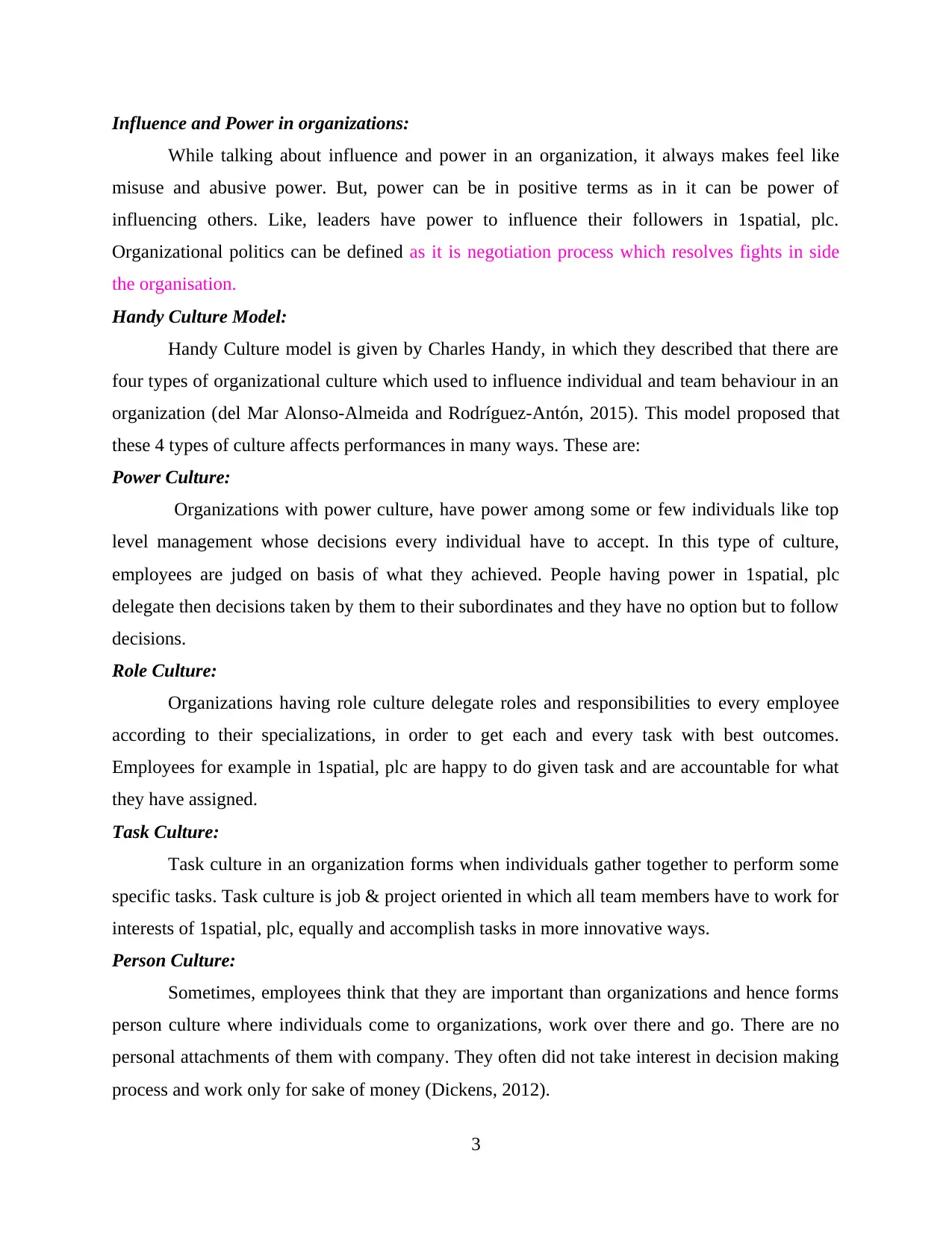
Influence and Power in organizations:
While talking about influence and power in an organization, it always makes feel like
misuse and abusive power. But, power can be in positive terms as in it can be power of
influencing others. Like, leaders have power to influence their followers in 1spatial, plc.
Organizational politics can be defined as it is negotiation process which resolves fights in side
the organisation.
Handy Culture Model:
Handy Culture model is given by Charles Handy, in which they described that there are
four types of organizational culture which used to influence individual and team behaviour in an
organization (del Mar Alonso-Almeida and Rodríguez-Antón, 2015). This model proposed that
these 4 types of culture affects performances in many ways. These are:
Power Culture:
Organizations with power culture, have power among some or few individuals like top
level management whose decisions every individual have to accept. In this type of culture,
employees are judged on basis of what they achieved. People having power in 1spatial, plc
delegate then decisions taken by them to their subordinates and they have no option but to follow
decisions.
Role Culture:
Organizations having role culture delegate roles and responsibilities to every employee
according to their specializations, in order to get each and every task with best outcomes.
Employees for example in 1spatial, plc are happy to do given task and are accountable for what
they have assigned.
Task Culture:
Task culture in an organization forms when individuals gather together to perform some
specific tasks. Task culture is job & project oriented in which all team members have to work for
interests of 1spatial, plc, equally and accomplish tasks in more innovative ways.
Person Culture:
Sometimes, employees think that they are important than organizations and hence forms
person culture where individuals come to organizations, work over there and go. There are no
personal attachments of them with company. They often did not take interest in decision making
process and work only for sake of money (Dickens, 2012).
3
While talking about influence and power in an organization, it always makes feel like
misuse and abusive power. But, power can be in positive terms as in it can be power of
influencing others. Like, leaders have power to influence their followers in 1spatial, plc.
Organizational politics can be defined as it is negotiation process which resolves fights in side
the organisation.
Handy Culture Model:
Handy Culture model is given by Charles Handy, in which they described that there are
four types of organizational culture which used to influence individual and team behaviour in an
organization (del Mar Alonso-Almeida and Rodríguez-Antón, 2015). This model proposed that
these 4 types of culture affects performances in many ways. These are:
Power Culture:
Organizations with power culture, have power among some or few individuals like top
level management whose decisions every individual have to accept. In this type of culture,
employees are judged on basis of what they achieved. People having power in 1spatial, plc
delegate then decisions taken by them to their subordinates and they have no option but to follow
decisions.
Role Culture:
Organizations having role culture delegate roles and responsibilities to every employee
according to their specializations, in order to get each and every task with best outcomes.
Employees for example in 1spatial, plc are happy to do given task and are accountable for what
they have assigned.
Task Culture:
Task culture in an organization forms when individuals gather together to perform some
specific tasks. Task culture is job & project oriented in which all team members have to work for
interests of 1spatial, plc, equally and accomplish tasks in more innovative ways.
Person Culture:
Sometimes, employees think that they are important than organizations and hence forms
person culture where individuals come to organizations, work over there and go. There are no
personal attachments of them with company. They often did not take interest in decision making
process and work only for sake of money (Dickens, 2012).
3
⊘ This is a preview!⊘
Do you want full access?
Subscribe today to unlock all pages.

Trusted by 1+ million students worldwide
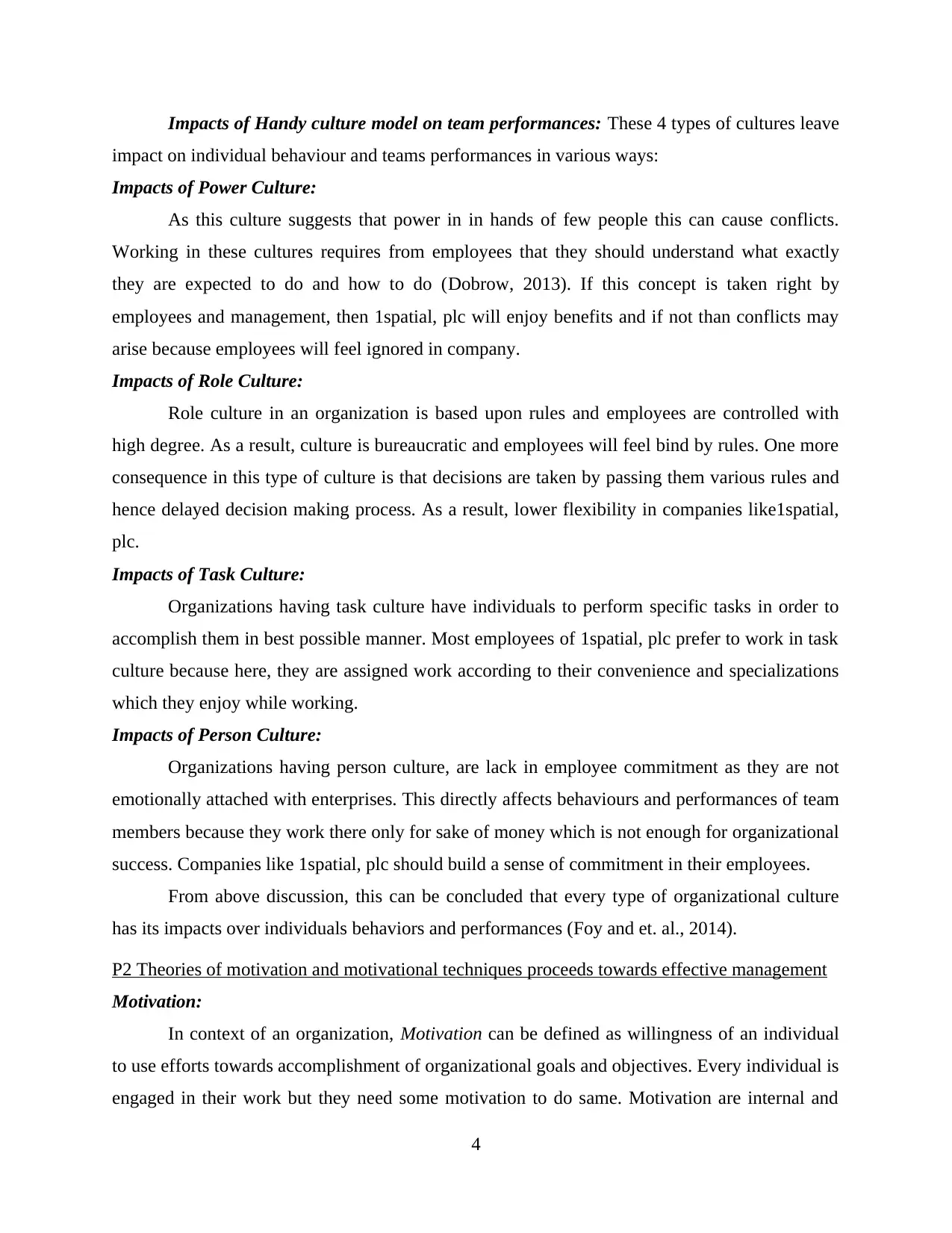
Impacts of Handy culture model on team performances: These 4 types of cultures leave
impact on individual behaviour and teams performances in various ways:
Impacts of Power Culture:
As this culture suggests that power in in hands of few people this can cause conflicts.
Working in these cultures requires from employees that they should understand what exactly
they are expected to do and how to do (Dobrow, 2013). If this concept is taken right by
employees and management, then 1spatial, plc will enjoy benefits and if not than conflicts may
arise because employees will feel ignored in company.
Impacts of Role Culture:
Role culture in an organization is based upon rules and employees are controlled with
high degree. As a result, culture is bureaucratic and employees will feel bind by rules. One more
consequence in this type of culture is that decisions are taken by passing them various rules and
hence delayed decision making process. As a result, lower flexibility in companies like1spatial,
plc.
Impacts of Task Culture:
Organizations having task culture have individuals to perform specific tasks in order to
accomplish them in best possible manner. Most employees of 1spatial, plc prefer to work in task
culture because here, they are assigned work according to their convenience and specializations
which they enjoy while working.
Impacts of Person Culture:
Organizations having person culture, are lack in employee commitment as they are not
emotionally attached with enterprises. This directly affects behaviours and performances of team
members because they work there only for sake of money which is not enough for organizational
success. Companies like 1spatial, plc should build a sense of commitment in their employees.
From above discussion, this can be concluded that every type of organizational culture
has its impacts over individuals behaviors and performances (Foy and et. al., 2014).
P2 Theories of motivation and motivational techniques proceeds towards effective management
Motivation:
In context of an organization, Motivation can be defined as willingness of an individual
to use efforts towards accomplishment of organizational goals and objectives. Every individual is
engaged in their work but they need some motivation to do same. Motivation are internal and
4
impact on individual behaviour and teams performances in various ways:
Impacts of Power Culture:
As this culture suggests that power in in hands of few people this can cause conflicts.
Working in these cultures requires from employees that they should understand what exactly
they are expected to do and how to do (Dobrow, 2013). If this concept is taken right by
employees and management, then 1spatial, plc will enjoy benefits and if not than conflicts may
arise because employees will feel ignored in company.
Impacts of Role Culture:
Role culture in an organization is based upon rules and employees are controlled with
high degree. As a result, culture is bureaucratic and employees will feel bind by rules. One more
consequence in this type of culture is that decisions are taken by passing them various rules and
hence delayed decision making process. As a result, lower flexibility in companies like1spatial,
plc.
Impacts of Task Culture:
Organizations having task culture have individuals to perform specific tasks in order to
accomplish them in best possible manner. Most employees of 1spatial, plc prefer to work in task
culture because here, they are assigned work according to their convenience and specializations
which they enjoy while working.
Impacts of Person Culture:
Organizations having person culture, are lack in employee commitment as they are not
emotionally attached with enterprises. This directly affects behaviours and performances of team
members because they work there only for sake of money which is not enough for organizational
success. Companies like 1spatial, plc should build a sense of commitment in their employees.
From above discussion, this can be concluded that every type of organizational culture
has its impacts over individuals behaviors and performances (Foy and et. al., 2014).
P2 Theories of motivation and motivational techniques proceeds towards effective management
Motivation:
In context of an organization, Motivation can be defined as willingness of an individual
to use efforts towards accomplishment of organizational goals and objectives. Every individual is
engaged in their work but they need some motivation to do same. Motivation are internal and
4
Paraphrase This Document
Need a fresh take? Get an instant paraphrase of this document with our AI Paraphraser
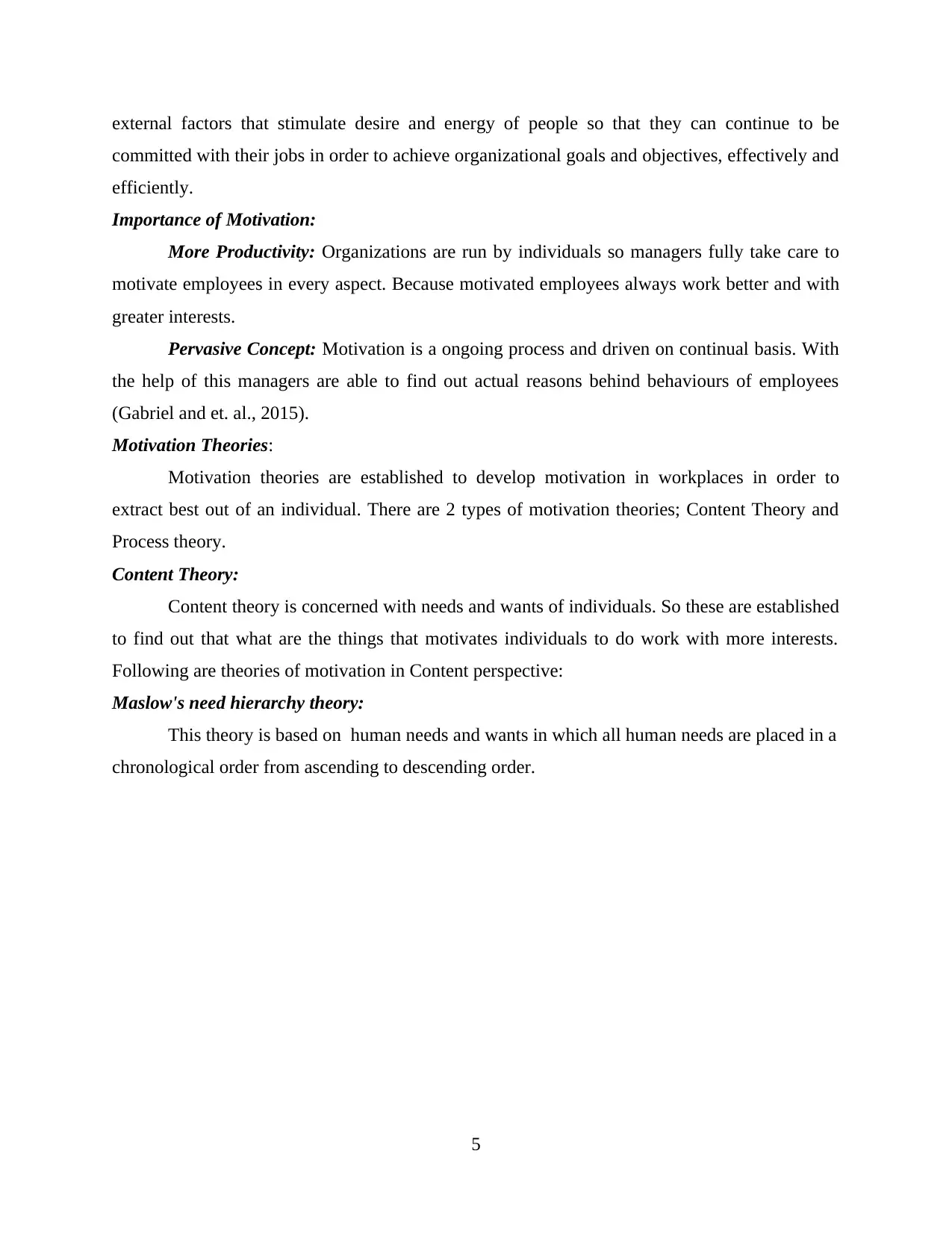
external factors that stimulate desire and energy of people so that they can continue to be
committed with their jobs in order to achieve organizational goals and objectives, effectively and
efficiently.
Importance of Motivation:
More Productivity: Organizations are run by individuals so managers fully take care to
motivate employees in every aspect. Because motivated employees always work better and with
greater interests.
Pervasive Concept: Motivation is a ongoing process and driven on continual basis. With
the help of this managers are able to find out actual reasons behind behaviours of employees
(Gabriel and et. al., 2015).
Motivation Theories:
Motivation theories are established to develop motivation in workplaces in order to
extract best out of an individual. There are 2 types of motivation theories; Content Theory and
Process theory.
Content Theory:
Content theory is concerned with needs and wants of individuals. So these are established
to find out that what are the things that motivates individuals to do work with more interests.
Following are theories of motivation in Content perspective:
Maslow's need hierarchy theory:
This theory is based on human needs and wants in which all human needs are placed in a
chronological order from ascending to descending order.
5
committed with their jobs in order to achieve organizational goals and objectives, effectively and
efficiently.
Importance of Motivation:
More Productivity: Organizations are run by individuals so managers fully take care to
motivate employees in every aspect. Because motivated employees always work better and with
greater interests.
Pervasive Concept: Motivation is a ongoing process and driven on continual basis. With
the help of this managers are able to find out actual reasons behind behaviours of employees
(Gabriel and et. al., 2015).
Motivation Theories:
Motivation theories are established to develop motivation in workplaces in order to
extract best out of an individual. There are 2 types of motivation theories; Content Theory and
Process theory.
Content Theory:
Content theory is concerned with needs and wants of individuals. So these are established
to find out that what are the things that motivates individuals to do work with more interests.
Following are theories of motivation in Content perspective:
Maslow's need hierarchy theory:
This theory is based on human needs and wants in which all human needs are placed in a
chronological order from ascending to descending order.
5
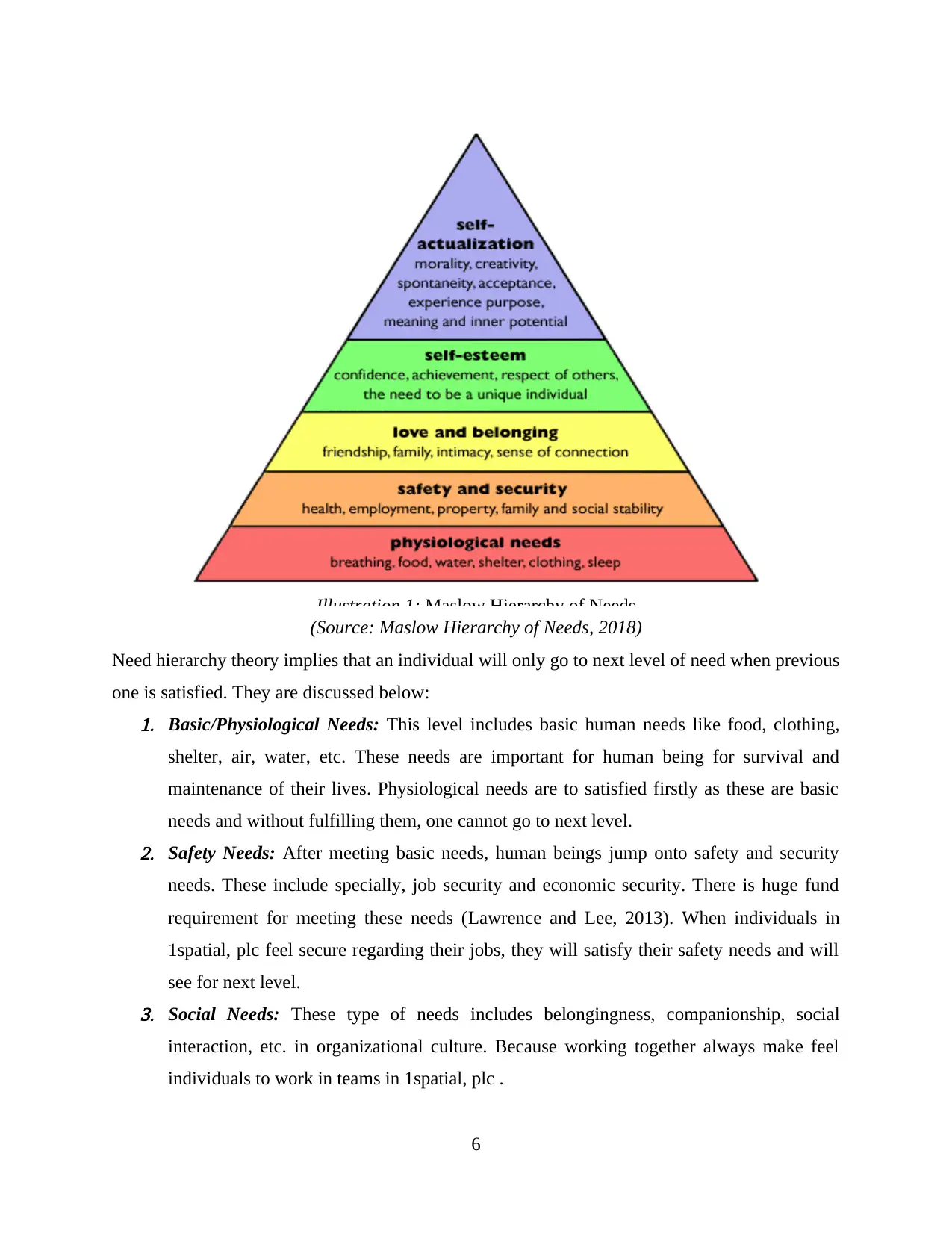
(Source: Maslow Hierarchy of Needs, 2018)
Need hierarchy theory implies that an individual will only go to next level of need when previous
one is satisfied. They are discussed below:1. Basic/Physiological Needs: This level includes basic human needs like food, clothing,
shelter, air, water, etc. These needs are important for human being for survival and
maintenance of their lives. Physiological needs are to satisfied firstly as these are basic
needs and without fulfilling them, one cannot go to next level.2. Safety Needs: After meeting basic needs, human beings jump onto safety and security
needs. These include specially, job security and economic security. There is huge fund
requirement for meeting these needs (Lawrence and Lee, 2013). When individuals in
1spatial, plc feel secure regarding their jobs, they will satisfy their safety needs and will
see for next level.3. Social Needs: These type of needs includes belongingness, companionship, social
interaction, etc. in organizational culture. Because working together always make feel
individuals to work in teams in 1spatial, plc .
6
Illustration 1: Maslow Hierarchy of Needs
Need hierarchy theory implies that an individual will only go to next level of need when previous
one is satisfied. They are discussed below:1. Basic/Physiological Needs: This level includes basic human needs like food, clothing,
shelter, air, water, etc. These needs are important for human being for survival and
maintenance of their lives. Physiological needs are to satisfied firstly as these are basic
needs and without fulfilling them, one cannot go to next level.2. Safety Needs: After meeting basic needs, human beings jump onto safety and security
needs. These include specially, job security and economic security. There is huge fund
requirement for meeting these needs (Lawrence and Lee, 2013). When individuals in
1spatial, plc feel secure regarding their jobs, they will satisfy their safety needs and will
see for next level.3. Social Needs: These type of needs includes belongingness, companionship, social
interaction, etc. in organizational culture. Because working together always make feel
individuals to work in teams in 1spatial, plc .
6
Illustration 1: Maslow Hierarchy of Needs
⊘ This is a preview!⊘
Do you want full access?
Subscribe today to unlock all pages.

Trusted by 1+ million students worldwide
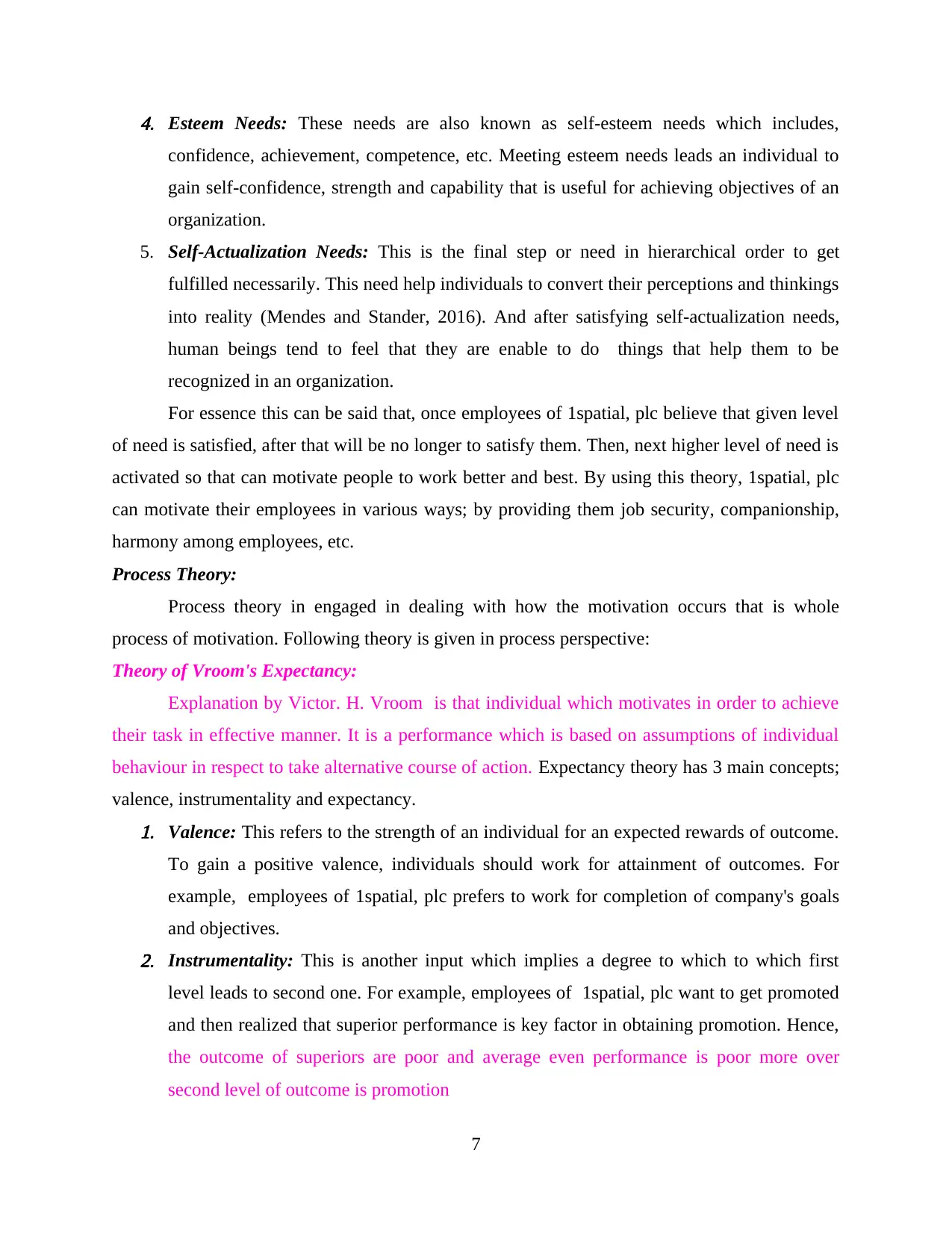
4. Esteem Needs: These needs are also known as self-esteem needs which includes,
confidence, achievement, competence, etc. Meeting esteem needs leads an individual to
gain self-confidence, strength and capability that is useful for achieving objectives of an
organization.
5. Self-Actualization Needs: This is the final step or need in hierarchical order to get
fulfilled necessarily. This need help individuals to convert their perceptions and thinkings
into reality (Mendes and Stander, 2016). And after satisfying self-actualization needs,
human beings tend to feel that they are enable to do things that help them to be
recognized in an organization.
For essence this can be said that, once employees of 1spatial, plc believe that given level
of need is satisfied, after that will be no longer to satisfy them. Then, next higher level of need is
activated so that can motivate people to work better and best. By using this theory, 1spatial, plc
can motivate their employees in various ways; by providing them job security, companionship,
harmony among employees, etc.
Process Theory:
Process theory in engaged in dealing with how the motivation occurs that is whole
process of motivation. Following theory is given in process perspective:
Theory of Vroom's Expectancy:
Explanation by Victor. H. Vroom is that individual which motivates in order to achieve
their task in effective manner. It is a performance which is based on assumptions of individual
behaviour in respect to take alternative course of action. Expectancy theory has 3 main concepts;
valence, instrumentality and expectancy.1. Valence: This refers to the strength of an individual for an expected rewards of outcome.
To gain a positive valence, individuals should work for attainment of outcomes. For
example, employees of 1spatial, plc prefers to work for completion of company's goals
and objectives.2. Instrumentality: This is another input which implies a degree to which to which first
level leads to second one. For example, employees of 1spatial, plc want to get promoted
and then realized that superior performance is key factor in obtaining promotion. Hence,
the outcome of superiors are poor and average even performance is poor more over
second level of outcome is promotion
7
confidence, achievement, competence, etc. Meeting esteem needs leads an individual to
gain self-confidence, strength and capability that is useful for achieving objectives of an
organization.
5. Self-Actualization Needs: This is the final step or need in hierarchical order to get
fulfilled necessarily. This need help individuals to convert their perceptions and thinkings
into reality (Mendes and Stander, 2016). And after satisfying self-actualization needs,
human beings tend to feel that they are enable to do things that help them to be
recognized in an organization.
For essence this can be said that, once employees of 1spatial, plc believe that given level
of need is satisfied, after that will be no longer to satisfy them. Then, next higher level of need is
activated so that can motivate people to work better and best. By using this theory, 1spatial, plc
can motivate their employees in various ways; by providing them job security, companionship,
harmony among employees, etc.
Process Theory:
Process theory in engaged in dealing with how the motivation occurs that is whole
process of motivation. Following theory is given in process perspective:
Theory of Vroom's Expectancy:
Explanation by Victor. H. Vroom is that individual which motivates in order to achieve
their task in effective manner. It is a performance which is based on assumptions of individual
behaviour in respect to take alternative course of action. Expectancy theory has 3 main concepts;
valence, instrumentality and expectancy.1. Valence: This refers to the strength of an individual for an expected rewards of outcome.
To gain a positive valence, individuals should work for attainment of outcomes. For
example, employees of 1spatial, plc prefers to work for completion of company's goals
and objectives.2. Instrumentality: This is another input which implies a degree to which to which first
level leads to second one. For example, employees of 1spatial, plc want to get promoted
and then realized that superior performance is key factor in obtaining promotion. Hence,
the outcome of superiors are poor and average even performance is poor more over
second level of outcome is promotion
7
Paraphrase This Document
Need a fresh take? Get an instant paraphrase of this document with our AI Paraphraser
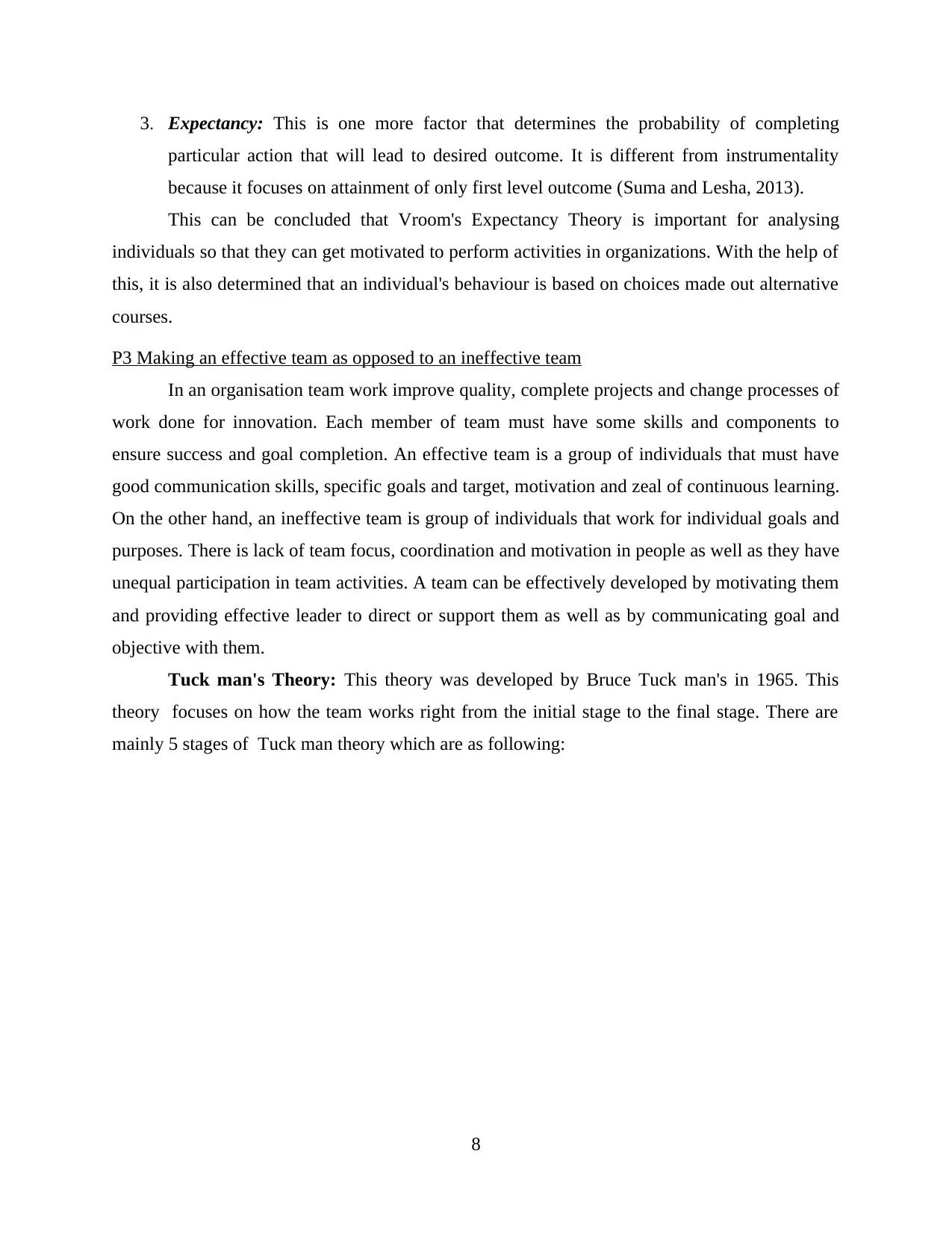
3. Expectancy: This is one more factor that determines the probability of completing
particular action that will lead to desired outcome. It is different from instrumentality
because it focuses on attainment of only first level outcome (Suma and Lesha, 2013).
This can be concluded that Vroom's Expectancy Theory is important for analysing
individuals so that they can get motivated to perform activities in organizations. With the help of
this, it is also determined that an individual's behaviour is based on choices made out alternative
courses.
P3 Making an effective team as opposed to an ineffective team
In an organisation team work improve quality, complete projects and change processes of
work done for innovation. Each member of team must have some skills and components to
ensure success and goal completion. An effective team is a group of individuals that must have
good communication skills, specific goals and target, motivation and zeal of continuous learning.
On the other hand, an ineffective team is group of individuals that work for individual goals and
purposes. There is lack of team focus, coordination and motivation in people as well as they have
unequal participation in team activities. A team can be effectively developed by motivating them
and providing effective leader to direct or support them as well as by communicating goal and
objective with them.
Tuck man's Theory: This theory was developed by Bruce Tuck man's in 1965. This
theory focuses on how the team works right from the initial stage to the final stage. There are
mainly 5 stages of Tuck man theory which are as following:
8
particular action that will lead to desired outcome. It is different from instrumentality
because it focuses on attainment of only first level outcome (Suma and Lesha, 2013).
This can be concluded that Vroom's Expectancy Theory is important for analysing
individuals so that they can get motivated to perform activities in organizations. With the help of
this, it is also determined that an individual's behaviour is based on choices made out alternative
courses.
P3 Making an effective team as opposed to an ineffective team
In an organisation team work improve quality, complete projects and change processes of
work done for innovation. Each member of team must have some skills and components to
ensure success and goal completion. An effective team is a group of individuals that must have
good communication skills, specific goals and target, motivation and zeal of continuous learning.
On the other hand, an ineffective team is group of individuals that work for individual goals and
purposes. There is lack of team focus, coordination and motivation in people as well as they have
unequal participation in team activities. A team can be effectively developed by motivating them
and providing effective leader to direct or support them as well as by communicating goal and
objective with them.
Tuck man's Theory: This theory was developed by Bruce Tuck man's in 1965. This
theory focuses on how the team works right from the initial stage to the final stage. There are
mainly 5 stages of Tuck man theory which are as following:
8
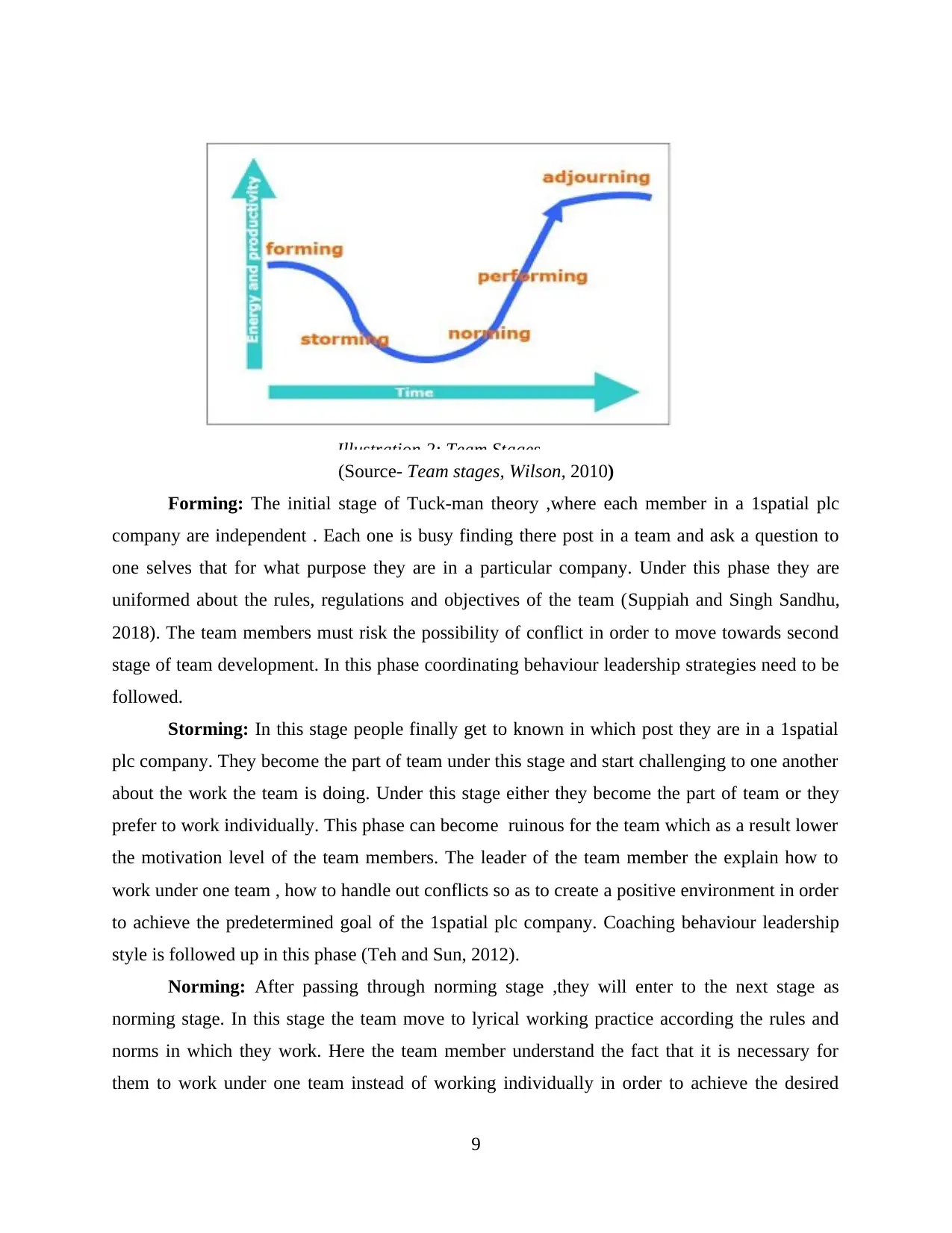
(Source- Team stages, Wilson, 2010)
Forming: The initial stage of Tuck-man theory ,where each member in a 1spatial plc
company are independent . Each one is busy finding there post in a team and ask a question to
one selves that for what purpose they are in a particular company. Under this phase they are
uniformed about the rules, regulations and objectives of the team (Suppiah and Singh Sandhu,
2018). The team members must risk the possibility of conflict in order to move towards second
stage of team development. In this phase coordinating behaviour leadership strategies need to be
followed.
Storming: In this stage people finally get to known in which post they are in a 1spatial
plc company. They become the part of team under this stage and start challenging to one another
about the work the team is doing. Under this stage either they become the part of team or they
prefer to work individually. This phase can become ruinous for the team which as a result lower
the motivation level of the team members. The leader of the team member the explain how to
work under one team , how to handle out conflicts so as to create a positive environment in order
to achieve the predetermined goal of the 1spatial plc company. Coaching behaviour leadership
style is followed up in this phase (Teh and Sun, 2012).
Norming: After passing through norming stage ,they will enter to the next stage as
norming stage. In this stage the team move to lyrical working practice according the rules and
norms in which they work. Here the team member understand the fact that it is necessary for
them to work under one team instead of working individually in order to achieve the desired
9
Illustration 2: Team Stages
Forming: The initial stage of Tuck-man theory ,where each member in a 1spatial plc
company are independent . Each one is busy finding there post in a team and ask a question to
one selves that for what purpose they are in a particular company. Under this phase they are
uniformed about the rules, regulations and objectives of the team (Suppiah and Singh Sandhu,
2018). The team members must risk the possibility of conflict in order to move towards second
stage of team development. In this phase coordinating behaviour leadership strategies need to be
followed.
Storming: In this stage people finally get to known in which post they are in a 1spatial
plc company. They become the part of team under this stage and start challenging to one another
about the work the team is doing. Under this stage either they become the part of team or they
prefer to work individually. This phase can become ruinous for the team which as a result lower
the motivation level of the team members. The leader of the team member the explain how to
work under one team , how to handle out conflicts so as to create a positive environment in order
to achieve the predetermined goal of the 1spatial plc company. Coaching behaviour leadership
style is followed up in this phase (Teh and Sun, 2012).
Norming: After passing through norming stage ,they will enter to the next stage as
norming stage. In this stage the team move to lyrical working practice according the rules and
norms in which they work. Here the team member understand the fact that it is necessary for
them to work under one team instead of working individually in order to achieve the desired
9
Illustration 2: Team Stages
⊘ This is a preview!⊘
Do you want full access?
Subscribe today to unlock all pages.

Trusted by 1+ million students worldwide
1 out of 19
Related Documents
Your All-in-One AI-Powered Toolkit for Academic Success.
+13062052269
info@desklib.com
Available 24*7 on WhatsApp / Email
![[object Object]](/_next/static/media/star-bottom.7253800d.svg)
Unlock your academic potential
Copyright © 2020–2025 A2Z Services. All Rights Reserved. Developed and managed by ZUCOL.




